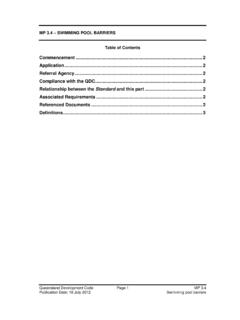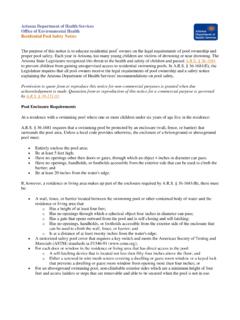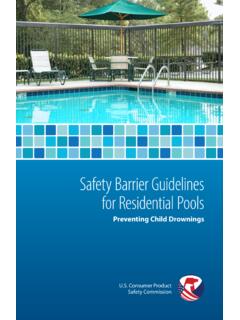Transcription of TEACHING SWIMMING SWIMMING AND WATER SAFETY …
1 TEACHING SWIMMING AND WATER SAFETY AT KEY STAGE 1 OR 2A GUIDE FOR SWIMMING TEACHERSSWIMMING TEACHERSD eveloped by the Swim Group to support SWIMMING teachers to deliver high quality SWIMMING and WATER SAFETY lessons for primary school pupils at Key Stage 1 or SWIMMING and WATER SAFETY at Key Stage 1 or 2: A guide for SWIMMING teachers2 This guide has been produced by Swim England on behalf of the Swim Group. The content has been developed by experts from a range of organisations involved in the provision of SWIMMING and WATER SAFETY lessons in primary schools. This series of guides for primary schools, parents, pool operators and SWIMMING teachers, is designed to ensure all children meet the requirements of the national curriculum PE programme of study by the time they leave primary school in Year also aims to ensure the consistent delivery of SWIMMING and WATER SAFETY lessons across the country that fully support the TEACHING of the three outcomes.
2 For more information and support materials visit TEACHING SWIMMING and WATER SAFETY at Key Stage 1 or 2: A guide for SWIMMING teachers3 CONTENTSThe importance of TEACHING SWIMMING and WATER SAFETY at primary school ..4 National curriculum requirements: SWIMMING and WATER SAFETY ..5 The three national curriculum requirements ..5 What do the outcomes mean? ..6 Beyond the minimum requirements ..7 Delivering a school SWIMMING and WATER SAFETY programme ..8 Roles and responsibilities ..9 Overview of what to teach ..10 Assessing progress and attainment ..11 Assessment scenario ..12 TEACHING qualifications ..12 Class ratios ..12 Planning school SWIMMING lessons ..13 During the lesson ..14 Additional support ..15 Key tips for SWIMMING teachers ..15 More information ..16 Additional links ..16 Appendix.
3 17 Published by the Swim Group March 2019 Design by SWIMMING and WATER SAFETY at Key Stage 1 or 2: A guide for SWIMMING teachers4 THE IMPORTANCE OF TEACHING SWIMMING AND WATER SAFETY AT PRIMARY SCHOOLBy the time a child is ready to leave primary school they should be able to swim, know how to get out of trouble if they fall into WATER , know the dangers of WATER and understand how to stay safe when playing in and around it. It is part of the national curriculum PE programme of study for England, so all local authority-maintained primary schools must provide SWIMMING and WATER SAFETY instruction. Other state funded schools, like academies and free schools, must provide a broad and balanced education and that should include TEACHING pupils to learn how to swim and about WATER teachers are in the perfect position to support schools to fulfill their statutory obligation to teach SWIMMING and WATER SAFETY to all pupils during Key Stage 1 or Key Stage 2.
4 The national curriculum sets out three outcomes which all pupils must be able to demonstrate they can meet before they leave Year 6. This guide is designed to help SWIMMING teachers - whether employed by the school or through third party providers - to understand what primary schools are required to teach and report on. It also sets out some important considerations for how SWIMMING teachers can support the schools make the most of the lessons. SWIMMING and WATER SAFETY is included within the national curriculum PE programme of school is the only opportunity some young people will have to learn these important life-enhancing and potentially life-saving a good experience at school will help to build a life-long SWIMMING habit which could include numerous WATER -based activities. 123 TEACHING SWIMMING and WATER SAFETY at Key Stage 1 or 2: A guide for SWIMMING teachers5 NATIONAL CURRICULUM REQUIREMENTS: SWIMMING AND WATER SAFETYU nlike other Learn to Swim programmes, the national curriculum SWIMMING and WATER SAFETY programme has only three outcomes.
5 These are statutory minimum standards of capability and confidence in SWIMMING and WATER SAFETY . It is important that all pupils are supported to meet these requirements before they leave primary school. This includes those with special educational needs, those with a disability or impairment and those whose first language is not English. The overall aim of primary school SWIMMING and WATER SAFETY instruction is to introduce children to the WATER - particularly those who may not have already been in a SWIMMING pool or had lessons. The emphasis is on ensuring all pupils have the basic skills to be able to enjoy the WATER safely and know how to safe self-rescue if the worst happens. The programme is not about being able to swim the perfect breaststroke, but to instill a level of ability and fun that encourages young people to keep developing their WATER skills.
6 The three national curriculum requirementsThe minimum requirement is that, by the time they are ready to leave Key Stage 2, every child is able to: swim competently, confidently and proficiently over a distance of at least 25 metres use a range of strokes effectively perform safe self-rescue in different WATER -based situations1 It is expected that many pupils will achieve more than these minimum expectations. Therefore, school SWIMMING programmes should also provide opportunities for these pupils to further develop their confidence and WATER SWIMMING and WATER SAFETY at Key Stage 1 or 2: A guide for SWIMMING teachers6 What do the outcomes mean?1. Swim competently, confidently and proficiently over a distance of at least 25 metres This means demonstrating: a continuous swim of more than 25 metres without touching the side of the pool or the pool floor without the use of SWIMMING aids.
7 Whenever possible, at least part of the swim should be completed in deep WATER , defined as greater than shoulder depth. This is because competence and proficiency can t be assured if the swim takes place in shallow WATER only. the stroke, or strokes, are as strong at the end of the swim as at the start, and that the swim is completed without undue stress. the stroke or strokes are recognisable to an informed an ineffective stroke and just managing to swim 25 metres does not meet the minimum requirement. Nor does it provide the skills necessary for pupils to be able to self-rescue if they get into difficulty. A competent, confident and proficient swim over a distance of more than 25 metres is the minimum requirement to meet the national curriculum outcomes. It is hoped that a number of pupils will be able to swim significantly further, although evidence of this is not required for primary schools to officially record (although could be considered for parent and secondary school reporting).
8 2. Use a range of strokes effectivelyPupils should be able to use a range of strokes and make choices about the strokes they use to achieve different outcomes and be certain of success. To do this they need to experience simultaneous and alternating strokes, on their front and back, and be able to adapt them for a range of purposes and intended outcomes. Examples of an intended outcome might be a swim of 50 metres, or using an effective leg kick to tread WATER successfully. SWIMMING strokes do not have to be perfect, the emphasis should be on effectively achieving the required aim rather than precision hand or feet movements. Examples of adapting strokes for different outcomes: front crawlUse front crawl with face down and aquatic breathing to swim in a competitive raceUse front crawl with head up to play WATER poloUse a front crawl-type leg kick in a vertical position to tread waterTeaching SWIMMING and WATER SAFETY at Key Stage 1 or 2: A guide for SWIMMING teachers73.
9 Perform safe self-rescue in different WATER -based situationsPupils should know the dangers of WATER and understand how to act responsibly when playing in or near different WATER environments. This includes understanding and adhering to national and local WATER SAFETY advice, being able to use appropriate survival and self-rescue skills if they unintentionally fall in or get into difficulty in the WATER , and knowing what to do if others get into trouble. To ensure pupils fully understand this important area, WATER -based situations should not only cover how an incident could occur, but also different types of WATER space. To support this, schools are encouraged to take advantage of additional programmes such as Swim of how an incident could occur:Falling into WATER when playing on a footpathFalling out of a boatSwimming in clothesBecoming tiredSustaining an injuryBeing out of one s depthHampered by weeds or underwater hazardsRough WATER or tidesExamples of where an incident could occur:Homes and gardensSwimming poolsBeachesRiversCanalsReservoirsBeyond the minimum requirementsSchool SWIMMING programmes must give regard to three elements of the national curriculum requirements for SWIMMING and WATER SAFETY but this should not limit the opportunities made available to all pupils to make progress and achieve.
10 To ensure pupils really are competent, confident and proficient in WATER , and have the ability to survive and self-rescue skills, it is best practice to look beyond the minimum requirements. Additionally, within a class or year group, pupils are likely to hold a range of abilities in these areas. Regardless of prior SWIMMING experience, primary schools are encouraged to provide the same lessons to all pupils to provide consistency. This is particularly important with regard to the WATER SAFETY elements as this is an area which can never be over-taught. For pupils who reach the minimum SWIMMING and stroke requirements quickly, it is important to provide access to other activities that will help them stay engaged and continue to grow their confidence and capabilities in the WATER . TEACHING SWIMMING and WATER SAFETY at Key Stage 1 or 2: A guide for SWIMMING teachers8 Examples of additional activities in the pool: Using a range of SWIMMING skills and strokes for different purposes.







